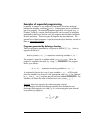
Page 21-16
where C
u
is a constant that depends on the system of units used [C
u
= 1.0 for
units of the International System (S.I.), and C
u
= 1.486 for units of the English
System (E.S.)], n is the Manning’s resistance coefficient, which depends on the
type of channel lining and other factors, y
0
is the flow depth, and S
0
is the
channel bed slope given as a dimensionless fraction.
Suppose that we want to create a function q(Cu, n, y0, S0) to calculate the unit
discharge q for this case. Use the expression
‘q(Cu,n,y0,S0)=Cu/n*y0^(5./3.)*√S0’,
as the argument of function DEFINE. Notice that the exponent 5./3., in the
equation, represents a ratio of real numbers due to the decimal points. Press
J, if needed, to recover the variable list. At this point there will be a
variable called @@@q@@@ in your soft menu key labels. To see the contents of q, use
‚@@@q@@@. The program generated by defining the function q(Cu,n,y0,S0)is
shown as:
« → Cu n y0 S0 ‘Cu/n*y0^(5./3.)*√S0’ ».
This is to be interpreted as “enter Cu, n, y0, S0, in that order, then calculate the
expression between quotes.” For example, to calculate q for Cu = 1.0, n =
0.012, y0 = 2 m, and S0 = 0.0001, use, in RPN mode:
1 ` 0.012 ` 2 ` 0.0001 ` @@@q@@@
The result is 2.6456684 (or, q = 2.6456684 m
2
/s).
Note: Values of the Manning’s coefficient, n, are available in tables as
dimensionless numbers, typically between 0.001 to 0.5. The value of Cu is
also used without dimensions. However, care should be taken to ensure that the
value of y0 has the proper units, i.e., m in S.I. and ft in E.S. The result for q is
returned in the proper units of the corresponding system in use, i.e., m
2
/s in S.I.
and ft
2
/s in E.S. Manning’s equation is, therefore, not dimensionally consistent.


















